| 1 | The rarest hognose snake |
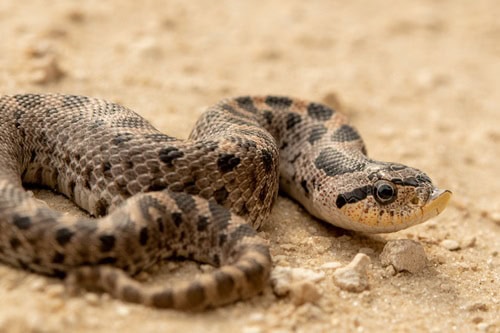
The USA has 3 main hognose snake species, including the western (Heterodon nasicus) and eastern hognose snakes (Heterodon platirhinos), which both inhabit a colossal swathe of the USA, and are estimated to number well over 100,000. The third and easily the least common is the southern hognose snake, which is estimated to number less than 10,000.
Southern hognose snakes (Heterodon simus) overlap with the eastern species, as their range includes Florida, North and South Carolina and Georgia. They were once present in Alabama and Mississippi, where they haven’t been sighted since the 1980s. Southern hognose snakes are classified as “vulnerable” by the IUCN, and have similar features to their cousins. They’re non-venomous, almost never bite humans, thick-bodied, and move relatively slowly. They inhabit areas with soft sandy soils, such as longleaf pine forests, turkey oak woods and dry sandhills, and virtually never appear in urbanised areas.
The southern is the smallest of the three species, with an average of 35-45cm, and an all-time record of just 61cm. The eastern hognose snake peaked at 115.5cm, while the western hognose record was 100.6cm.
| 2 | ID signs to remember |
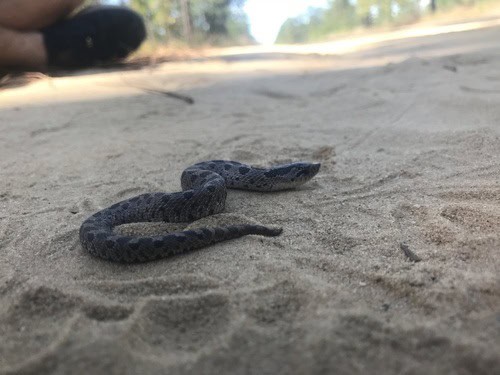
The most obvious distinguishing feature is the smaller size. A more hidden ID sign is the tail, which is always the same colour as the belly in southern hognose snakes. In the eastern species, the tail is lighter than the belly. Unlike the eastern form, southern hognose snakes are never uniformly black.
Then there’s the snout. Compared to eastern hognose snakes, which are more horizontal, Heterodon simus has a far more upturned snout, which is almost vertical in some individuals. This is similar to a western hognose snake, but luckily, westerns and southerns don’t overlap, so eastern is the only relative you have to compare to.
Despite being fully separated, western and southern hognose snakes are actually closer genetically than they are to the eastern. Heterodon simus is theorised to have originated in the Florida peninsular, where they became trapped during ice ages, before migrating outwards again after evolving in isolation.
| 3 | Super-narrow habitats |
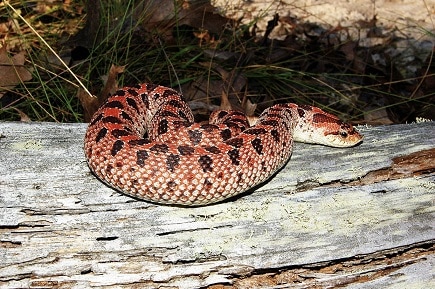
All hognose snakes associate with sandy soils, but southern hognose snakes are particularly dependent on them, as they’re the most fossorial (underground) of the three. They have a strong connection to longleaf pine ecosystems, which have sharply declined and now cover just 2% of their former territory.
Cars are another threat according to a 17 year North Carolina study. Of the 764 sightings made from 1985 to 2002, 643 were dead on roads. 110 were alive on roads, while the remainder (only 11) were away from roads, slithering calmly through their sandy longleaf pine habitat. The upside is that southern hognose snakes are very difficult to find, even in areas where they thrive. Nobody knows whether they survive in Mississippi and Alabama, where they haven’t been sighted in over 40 years.
Like panda bears and their bamboo obsession, southern hognose snakes may have fallen into an overly narrow evolutionary niche: a slow, sheltered lifestyle in sandy forests, which works well in limited numbers, but is too inflexible when new threats arrive.
| 4 | Freezes when confronted |
The study also found a difference between the species. Of the 110 southern hognose snakes found alive, playing dead was very rare. They only flipped over dramatically and went limp when manhandled for several seconds or held for photographs. Meanwhile, eastern hognose snakes in the same area “almost invariably” played dead when the scientists seized them in their grip.
Heterodon simus has the power, but rarely uses it. Instead, they tended to freeze when approached. They would cease all movement, or edge forward only in a jerky haphazard manner. One adult female remained motionless for 12 minutes while the scientists observed her. A handful did the opposite and blasted away rapidly. This tendency to freeze explains why southern hogose snakes constantly end up as roadkill.
The scientists also unearthed one hibernating female, in a self-dug burrow 47cm below ground. The underground chamber had a sturdy structure, with tightly packed sandy soil and firm pine tree roots.
| 5 | Almost never eat mammals |
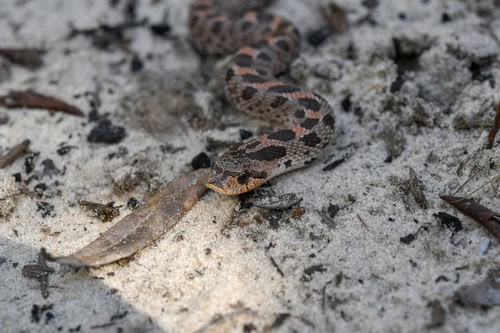
Southern hognose snakes were once considered to eat amphibians near exclusively, with one confirmed favourite being the southern toad (Anaxyrus terrestris). But fresher data came in the same North Carolina study. Firstly, there was a complete lack of mammals. Scientists found 26 food items in southern hognose stomachs, with 2 species dominating all, both with 12 apiece.
Eastern spadefoot (Scaphiopus holbrookii) – a toad which spends most of its life underground, burrowing down in a spiral motion. Only emerges at night, and not every night. Also confirmed prey of the eastern hognose snake.
Six-lined racerunner (Aspidoscelis sexlineata) – an extremely common lizard, which ranges from Maryland to Mexico. However, they’re most common in areas with dry sandy soils, similarly to southern hognose snakes.
Both are sandhill specialists, which offered clues about Heterdon simus’ hunting strategy: the scientists theorised that it digs its prey out of soft sandy soils, as opposed to waiting in ambush. This is believed to be the entire point of their upturned snouts. The other two prey recorded were a brown tree skink (1) and ground skink (1), making for a slight bias towards reptiles.
| 6 | Plentiful in certain locations |
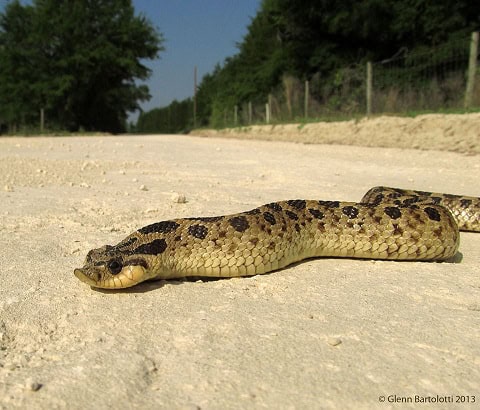
The same study revealed that Heterodon simus has some habitat flexibility and therefore isn’t completely doomed. 50% of road crossing sightings were between longleaf pine scrub-oak forests as expected, but smaller numbers were found on roads near agricultural fields, disturbed forests and old fields. From 1985 to 1995, the strongest months for sightings were overwhelmingly October (1st) and September (2nd), which towered over the rest.
While still fussy, they’re not as inflexible as the near extinct Louisiana pinesnake, which inhabits longleaf pine forests exclusively.
The scientists believed that North Carolina sandhills were one of the southern hognose snake’s remaining strongholds. They observed no decline from 1985 to 2002, and in fact, Heterodon simus was the most abundant snake, outnumbering its eastern cousin and the ubiquitous black racer. A 2012 study from Georgia and Alabama was very different, finding just 2 southern hognose snakes over 8 sample years. A 1987 study found twice as many eastern hognose snakes in South Carolina as southern.
| 7 | The fire ant threat |
One explanation might be that red fire ants aren’t as abundant in North Carolina yet. It’s a mixed picture, as according to the same 2014 study, of the 20 North Carolina counties with confirmed Heterodon simus records, only 10 had seen sightings in the last 20 years. Several hadn’t seen sightings for 40 years.
At the same time, this is a shy snake whose sand burrowing nature makes it hard to find. The southern hognose snake might be in decline, but there’s undoubtedly a few pockets where it continues to thrive.
Fire ants may assault southern hognose snakes directly, but they’re also theorised to decimate their prey like fence lizards. Where they coexist with fire ants naturally (South America), small lizards dash away rapidly, the correct choice. But in non-native places like South Carolina, fences lizards have been shown to freeze when confronted, exactly the wrong strategy when the ant swarm is about engulf you.
| 8 | Mothers abandon their eggs |
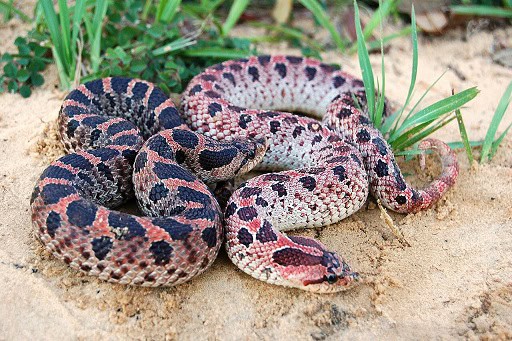
Heterodon simus is an egg-laying species, with a range of 6 to 14. These are laid from July to late September and take 55-70 days to hatch.
Mothers do the bare minimum. Not only do they not care for their offspring (unlike a timber rattlesnake), they abandon their eggs almost instantly. Only one Heterodon simus mother has ever been spotted defending its egg stash. The eggs are soft and leathery, and at birth, southern hognose snakes measure 13-17cm.
Starting on May 23rd 2020, scientists made one of the most detailed observations of a female southern hognose snake. They found her on a sand road in Scotland County, North Carolina, and implanted a non-invasive radio transmitter. The snake was clearly pregnant, and was set free to explore the nearby open sandhill habitats.
From June 6th to July 14th, the female spent almost all her time underground, in a single burrow of her own making. She emerged only twice, where she strayed no more than 5 metres from the dark entrance. From July 15th, she ventured more to the surface, and occupied 4 new burrows. On July 27th, scientists deemed that she was no longer pregnant. The female hognose snake was sadly found dead on August 10th, with wounds hinting strongly at raptor assault (bird of prey, not dinosaur).
| 9 | Nemesis: scarlet snake |
To find the eggs, scientists ventured to the original, longest-lasting burrow. By October 31st, no hatchlings had emerged, and so the scientists carefully excavated the burrow, revealing a 25cm deep chamber stabilised with subterranean Carolina wireglass roots.
Inside were 6 shrivelled, rotting eggs which kind of resembled almond biscuits. No live hatchlings were found. The eggs were found in a small side tunnel beginning 61cm after the entrance.
The eggs had clearly failed, but why? A clear clue was in evidence – the shed skin of a scarlet snake (Cemophora coccinea). This is one of the southeast USA’s most infamous egg predators. Scarlet snakes lack venom, but have enlarged front teeth they use to hack through shells to access the golden yolk, which they then drain. Turtle eggs are favoured, but southern hognose snakes are apparently another of their victims.
The whole story also showed how southern hognose snakes tend to vanish underground while preparing to give birth, in this case for 38 days, which were barely interrupted. This is partly why they cannot survive without soft sandy soils. Southern hognose snakes are also confirmed to fall victim to black racers (Coluber constrictor).
| 10 | Still resistant to toad toxins |
In captivity, it’s possible to make Heterodon simus eat mice with great difficulty, by artificially scenting them with toad skin secretions. Captives happily eat squirrel frogs and green tree frogs as well. One of the rarest wild prey was an ox beetle larva, estimated to measure 60mm. This was found in the stomach, not the intestine, proving that it was intentionally ingested, and not hidden in the stomach of the actual prey it was swallowing.
While it fakes death less commonly, Heterodon simus shares one great feature with the eastern hognose snake: complete resistance to bufotoxins in toads, which ordinarily bring the heartbeat to a total halt.
They also have enlarged rear teeth, which are designed for gripping slippery toads’ bodies. Some wildly speculate that the teeth are designed for puncturing toads when they inflate into balloons, but this has never been confirmed. Southern hognose snakes begin flecking their tongue much more rapidly and intensely whenever a southern toad is nearby.
| 11 | The oldest southern hognose snake |
Unlike boas or pythons, hognose snakes aren’t famed for their old age. 6-7 years is typical in the wild, but with careful captive care, they can continue unceasingly for years.
A previous record age was 12 years, 42 days, as reported by the Chicago Herpetological Society in 2007. This report also mentioned several that exceeded 11 years, considered impressive. But this record was demolished by a snake which died in 2015, at the grand old age of 18 years, 5 months and 24 days.
This snake was collected in the wild in October 1996, in Moore County, South Carolina. It was a recent hatchling, allowing them to judge its ultimate age almost to full accuracy. The southern hognose snake ate squirrel tree frogs and pine woods treefrogs from 1996 to 1998 but most impressively, they tricked it into eating storebought mice via frog scenting.
From 1998 to its death in 2015, the ageing southern hognose snake ate mice and rats exclusively, and not only survived, but thrived, despite studies finding zero mammals in their wild diet. In his last year, the elderly Heterodon simus struggled to swallow food, and one meal was gently prodded down his throat. He struggled with ecdysis (skin shedding) and developed cataracts in both eyes. The oldest ever southern hognose snake finally died on April 10th 2015, at 48.5cm.
